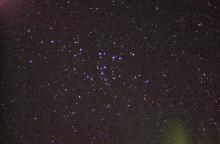Listen to today's episode of StarDate on the web the same day it airs in high-quality streaming audio without any extra ads or announcements. Choose a $8 one-month pass, or listen every day for a year for just $30.
You are here
North Poles
The Big Dipper moves high overhead this evening, with the bowl turned upside down. As you take in the view, link the two stars at the outer edge of the bowl. If you follow that line down toward the horizon, the first moderately bright star you come to is Polaris. Earth’s north pole aims directly at the star, so it’s also known as the North Star or the Pole Star — it marks true north in the sky.
Another north pole stands at about the same height at that hour. It’s in Coma Berenices, a faint constellation that’s well above Arcturus, a bright yellow-orange star that’s low in the east.
That spot marks the north galactic pole — the projection of the north pole of the Milky Way Galaxy.
The galaxy is shaped like a disk. It’s about a hundred thousand light-years across, and about ten thousand light-years thick. If you draw a line through the center of the galaxy, at a right angle to the disk, and project it above the disk, it aims toward Coma Berenices.
When we look in that direction, we’re looking through a thin section of the Milky Way, so there aren’t many really bright stars in that part of the sky. Instead, we’re looking into intergalactic space. And in fact, a telescope reveals many other galaxies in that direction. More than a thousand of them form a giant cluster, known as the Coma Cluster — a beautiful collection of galaxies that stands due north.
Tomorrow: A shower of space rocks pelts Illinois.
Script by Damond Benningfield





